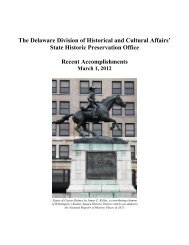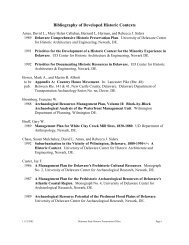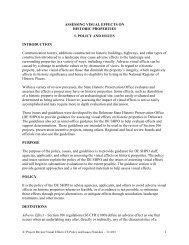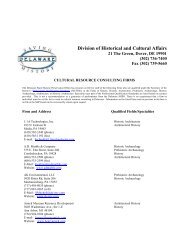Report of the Archaeological Investigations of the New Castle Court ...
Report of the Archaeological Investigations of the New Castle Court ...
Report of the Archaeological Investigations of the New Castle Court ...
You also want an ePaper? Increase the reach of your titles
YUMPU automatically turns print PDFs into web optimized ePapers that Google loves.
NEW CASTLE COURT HOUSE PLAZA<br />
NEW CASTLE, DELAWARE<br />
5.0 INTERPRETATION AND CONCLUSIONS<br />
was encountered in <strong>the</strong> section <strong>of</strong> <strong>the</strong> trench sampled, and <strong>the</strong> only evidence for posts was<br />
observed in <strong>the</strong> extreme base trench where mold staining was identified. As described above <strong>the</strong><br />
historical record indicates that <strong>the</strong> blockhouse had a palisade with a gate in 1677-78, but <strong>the</strong><br />
palisade was gone by 1684. The archeological evidence supports this relatively short time frame.<br />
Five years after Penn described <strong>the</strong> blockhouse cum courthouse and prison <strong>the</strong> property<br />
containing <strong>the</strong> building was formally laid out. In 1689 <strong>the</strong> lot was established by <strong>the</strong> Pennsylvania<br />
Land Office. In <strong>the</strong> detailed metes and bounds description it was noted that <strong>the</strong> lot was to be laid<br />
out “to <strong>the</strong> <strong>Court</strong>house” indicating a pre-existing building, not a new courthouse (Heite 1978:138-<br />
139). The stone foundation beneath <strong>the</strong> present <strong>Court</strong> House is thus <strong>the</strong> remains <strong>of</strong> this first<br />
blockhouse-courthouse-prison combination constructed in circa 1675. At <strong>the</strong> time it was burned<br />
to <strong>the</strong> ground by escapee William Kelsey circa 1730 <strong>the</strong> building was over fifty years old (Cario<br />
2001).<br />
5.4 THE MATERIAL CULTURE OF THE COURT HOUSE PLAZA<br />
The architecture <strong>of</strong> eighteenth-century court houses has been interpreted by scholars to symbolize<br />
a strong visual expression <strong>of</strong> social order and <strong>the</strong> rule <strong>of</strong> law, especially after <strong>the</strong> adoption <strong>of</strong><br />
Georgian architectural styles (cf. Whiffen 1958:152-161). <strong>Court</strong> houses, such as <strong>the</strong> <strong>New</strong> <strong>Castle</strong><br />
<strong>Court</strong> House and <strong>the</strong> one constructed in 1724 in neighboring Chester, Pennsylvania, are <strong>of</strong>ten<br />
interpreted as bringing order to <strong>the</strong> colonial frontier and as playing instrumental roles in <strong>the</strong><br />
establishment <strong>of</strong> American society (Kruse 1966; Patterson 1969).<br />
While court house architecture has received scholarly attention, <strong>the</strong> material world associated<br />
with court operations has not. Only a small number <strong>of</strong> eighteenth-century court house sites have<br />
been investigated archeologically. <strong>Investigations</strong> at <strong>the</strong> 1770 <strong>Court</strong> House in Williamsburg<br />
examined interior features principally for architectural restoration (Stamford 1986).<br />
Archeological work at <strong>the</strong> Delaware State House in Dover was also intended to support<br />
architectural restoration efforts (Wise 1976) and only recently has <strong>the</strong> artifact assemblage begun<br />
to be re-examined.<br />
More recently researchers have begun to examine <strong>the</strong> landscape surrounding court houses and to<br />
investigate <strong>the</strong> role <strong>of</strong> <strong>the</strong>se public buildings and <strong>the</strong>ir grounds played in <strong>the</strong> cycles <strong>of</strong> court days.<br />
The interpretation <strong>of</strong> courthouses as isolated public buildings divorced from daily activities in <strong>the</strong><br />
community is being questioned (Lounsbury 1985; 1989). The county courthouse was an integral<br />
part <strong>of</strong> <strong>the</strong> fabric <strong>of</strong> eighteenth-century social and cultural life. As interpreted by architectural<br />
historian Carl Lounsbury<br />
“The county courthouse did not stand majestically alo<strong>of</strong> from its surroundings as a<br />
symbolic monument to <strong>the</strong> power and authority <strong>of</strong> <strong>the</strong> gentry who built it and who ruled<br />
over local government....People came to <strong>the</strong> courthouse to be entertained and informed.<br />
Men and boys hung out <strong>of</strong> windows to hear <strong>the</strong> arguments <strong>of</strong> popular cases, athletes<br />
played fives against <strong>the</strong> brick walls much to <strong>the</strong> annoyance <strong>of</strong> those presiding inside,<br />
hawkers peddled spirituous beverages to hundreds <strong>of</strong> eager indulgers, merchants pinned<br />
notices on <strong>the</strong> front door calling attention to new merchandise, slave sales, and land<br />
auctions, and when court rose, itinerant ministers preached <strong>the</strong> gospel from <strong>the</strong> steps<br />
(Lounsbury 1985:9).<br />
At <strong>the</strong> <strong>New</strong> <strong>Castle</strong> <strong>Court</strong> House <strong>the</strong> archeological investigations were focused on <strong>the</strong> exterior<br />
public space <strong>of</strong> <strong>the</strong> plaza. This space, whe<strong>the</strong>r paved or unpaved ground, served as an assembly<br />
area for <strong>the</strong> citizens <strong>of</strong> <strong>the</strong> town, <strong>the</strong> county, <strong>the</strong> colony, and <strong>the</strong> state. A broad range <strong>of</strong> social<br />
activities, such as those described above by Lounsbury, would have taken place on <strong>the</strong> plaza.<br />
87









